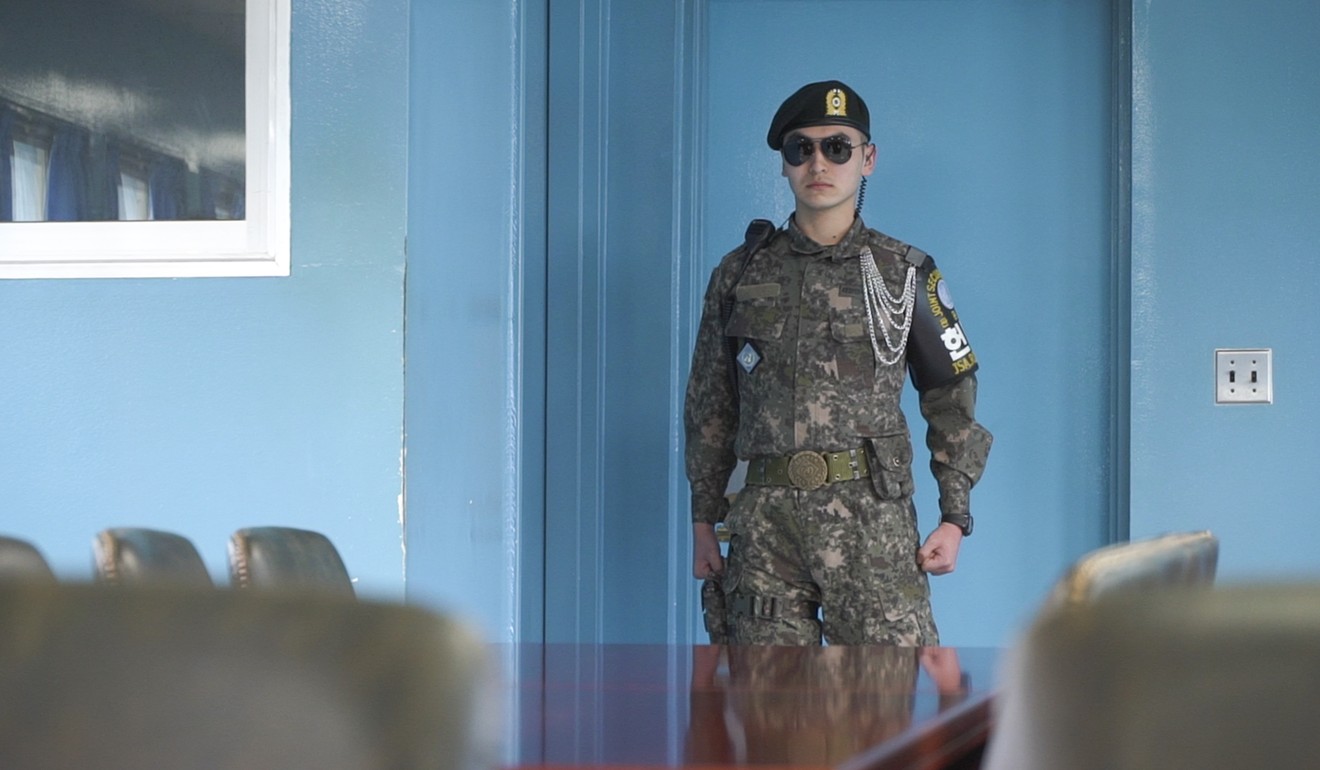
Joint Security Area’s ‘Peace House’ is spruced up as hopes rise for North and South Korea to strike reconciliatory note
Kim Jong-un may walk across the border in symbolic gesture to begin talks on denuclearising the Korean peninsula
The building that sits at the fortified border between the two Koreas is being renovated for a landmark summit that may pave the way for an end to the nations’ hostility.
It remains unknown how North Korean leader Kim Jong-un will travel to the Peace House – on the South Korean side of the Joint Security Area (JSA), in the border village of Panmunjom – for the talks with South Korean President Moon Jae-in.
But officials are making preparations for him to walk across the border, which would symbolise reconciliation, according to officials who briefed reporters on a media tour of the JSA on Wednesday.
No North Korean leader has walked across the Military Demarcation Line since the Korean war ended with an armistice agreement in 1953.
The JSA, visited by about 100,000 tourists a year, has been closed to the public since last week, with the Peace House being renovated to host talks scheduled for April 27.
The fortified border, where China, the United States and North Korea signed the 1953 agreement, has been used by the two Koreas for diplomatic engagement.
Belief is building that Moon and Kim may reach agreement in the talks on denuclearising the Korean peninsula.
A dozen workers have been working inside and around the grey three-storey building, including renovating the entrance, which had been covered with blue vinyl.
Located 130 metres from the Freedom House, South Korea’s propaganda base at the border, the Peace House was constructed to facilitate non-military meetings between South and North Korea – originally in 1980, then rebuilt in its present position in 1989. But as relations froze over the past decade, the building has usually been vacant.
Placed by the Peace House’s entrance are several pine trees – or “sonamu”, which literally means “chief tree” in Korean – to symbolise honour and strength, with workers frequently checking to ensure they are flawless.
Jacquelene Elise Van Pool, chief of community relations at the United States Forces Korea, noted that the North Korean delegation may walk across the border in a gesture of reconciliation.
“The North Korean leader’s method of entering South Korea, whether by walking or driving, implies the level of trust that exists between the two countries,” she said.

The first and second floors of the Peace House are made up of meeting rooms, while the third floor has a dining area, said Van Pool, who explained that entry to the building was prohibited for security reasons. The corridor walls had been repainted and security features added, officials said.
In total, six buildings were built straddling the borderline in the JSA. Three blue buildings were for use by the South, while the three white ones were to be managed by the North.
Inside one of the blue buildings is the Military Armistice Conference Room, containing brown tables at which the two sides are expected to hold talks across the very line of the border. The stationing of South Korean soldiers on the north side of the building notifies the North that the building is occupied.
In Beijing, a senior South Korean diplomat said that Seoul was finalising details with the North for the inter-Korea summit, including communications, protocols and news coverage.
South Korea has also been working closely with both China and the US for the summit meetings, said Choi Young-sam, the minister at South Korea’s embassy in China.
“We will continue and strengthen strategic communications with China while at the same time keep communication and coordination with the US to ensure maximum results” from the talks, Choi said at a press briefing on Thursday morning in Beijing.
The decision to hold the summit in the border village where the Koreas are divided is “of great significance”, Choi added.
“Panmunjom represents the confrontation and the division of the peninsula,” he said.
Despite preparations for a summit that could bring peace, the JSA remained tense on Wednesday and was heavily guarded by US and South Korean forces.
Six South Korean guards, along with three US guards, with clenched fists and sunglasses and armed with pistols, adopted a fierce Taekwondo-like stance at the border facing the North.
North Korean guards, meanwhile, were not present on the border. One soldier overlooked the South Korean soldiers from the second floor of the North’s grey propaganda building, the Panmungak, behind the row of blue and white buildings.
“We have bullet marks from when the recent North Korean defector came across the border,” Van Pool said. In November, a North Korean soldier drove toward the demarcation line in the JSA before getting out of his vehicle and running toward the South Korean side.
A group of North Korean soldiers had given chase and shot at him 40 times, but the escapee made it across to South Korea with severe injuries from five bullet wounds, according to the South.
It was a reminder of the continuing tension. “We are still technically under a war,” an official said.
“But I hope we make full use of this opportunity to restore momentum to make peace with the North.”
Additional reporting by Laura Zhou

